 By now, we’ve all read things about the Patient Protection and Affordable Care Act (PPACA), also known as Obamacare. One concern is the PPACA’s impact on early retirees, or really anyone who wants to buy their own non-employer health insurance? The PPACA is eliminating many high-deductible health plans which many such folks previously used due to their low premiums. But at the same time, many others who didn’t pass the medical screening were faced with astronomical premiums if you could get coverage at all. Could the PPACA actually improve the overall affordability of comprehensive health care?
By now, we’ve all read things about the Patient Protection and Affordable Care Act (PPACA), also known as Obamacare. One concern is the PPACA’s impact on early retirees, or really anyone who wants to buy their own non-employer health insurance? The PPACA is eliminating many high-deductible health plans which many such folks previously used due to their low premiums. But at the same time, many others who didn’t pass the medical screening were faced with astronomical premiums if you could get coverage at all. Could the PPACA actually improve the overall affordability of comprehensive health care?
I’m not going to claim I completely understand everything about the PPACA and I certainly won’t cover it all here, I can only try to provide concise a few examples with sources.
What do I get? First, let’s recap some basics about the insurance you can buy on the new exchanges. You can no longer be denied insurance due to your health history, minimum coverage levels were set for all plans, and certain preventative care services are now free without copays. Taken from the PPACA Wikipedia page:
Guaranteed issue prohibits insurers from denying coverage to individuals due to pre-existing conditions, and a partial community rating requires insurers to offer the same premium price to all applicants of the same age and geographical location without regard to gender or most pre-existing conditions (excluding tobacco use). […]
Under the law’s authorization, Secretary of Health Kathleen Sebelius issued a set of defined “essential health benefits”[22] that all new insurance plans have to include. […] Among the essential health benefits, preventive care, childhood immunizations and adult vaccinations, and medical screenings are covered by an insurance plan’s premiums, and cannot be subject to any co-payments, co-insurance, or deductibles.
Am I eligible for a subsidy? Subsidies for healthcare premiums are determined by your income relative to the Federal Poverty Level (FPL). Here are the 2014 FPLs by household size, as calculated by the Department of Health and Human Services (for 48 contiguous states, higher in Alaska and Hawaii).
| Persons in family/household | 100% FPL | 400% FPL |
|---|---|---|
| 1 | $11,670 | $46,680 |
| 2 | $15,730 | $62,920 |
| 3 | $19,790 | $79,160 |
| 4 | $23,850 | $95,400 |
| 5 | $27,910 | $111,640 |
Your household’s modified adjusted gross income (MAGI) must be below 400% FPL in order to receive a subsidy. As long as you are below 400% FPL, your health insurance premiums cannot exceed 9.5% of your income. Modified takes your AGI (Line 4 on a Form 1040EZ, Line 21 on a Form 1040A, or Line 37 on a Form 1040.) and adds back in certain deductions like non-taxable Social Security income, foreign income, and tax-exempt interest.
You may be surprised that a family of four could have an MAGI of $95,000 and still be eligible for a subsidy.
How much will it cost for a couple with no kids? Let’s assume a couple, both age 40, California resident, and $60,000 MAGI. This is under 400% FPL so they get a subsidy. California’s exchange website is CoveredCA.com. Here are results for a middle-of-the-road Silver plan for the couple with $60,000 income:
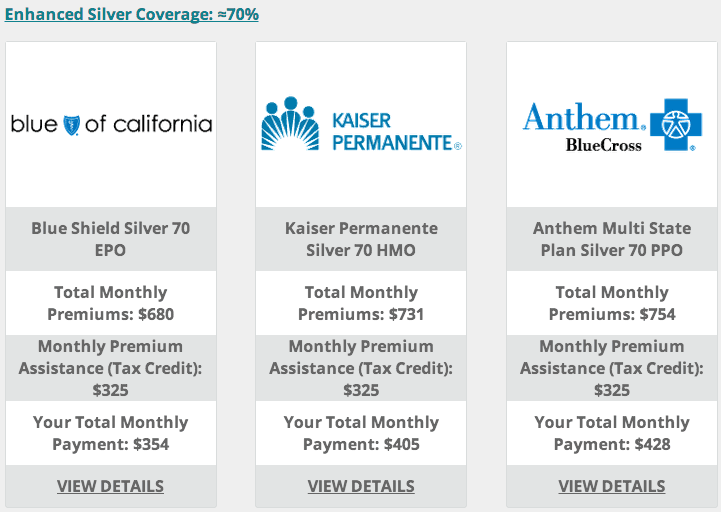
Let’s pick the cheapest Blue Cross Blue Shield option:
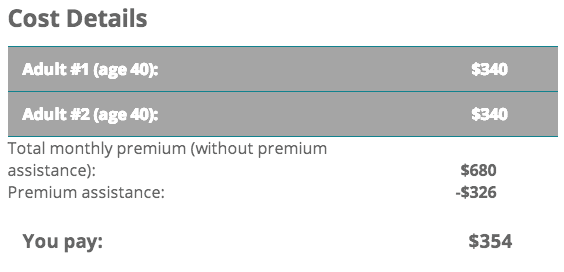
The total quoted was $354 a month, or $177 per person, per month after subsidies.
If they made $95,000 a year, then they would have no subsidy and be quoted just the flat $340 per month, per person.
How much will it cost for a family of four? Let’s try 2 adults, both 40 years old, and 2 dependents under 18. They live in California and make $60,000 MAGI a year. Here are results for a Silver plan for the family with $60,000 income:
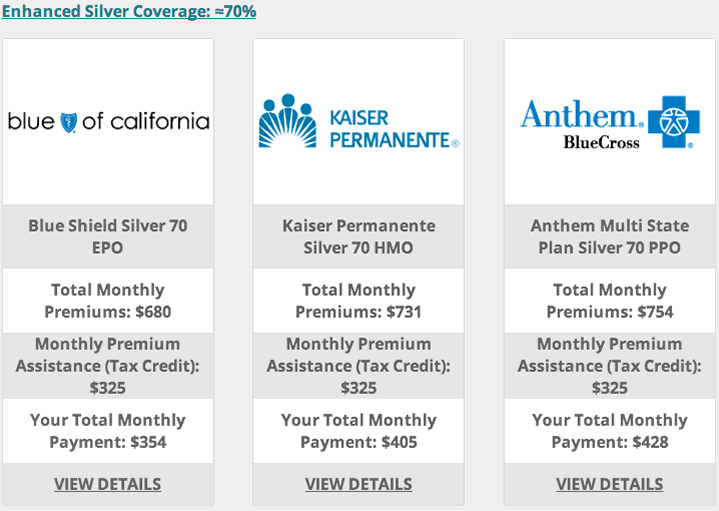
Let’s pick the cheapest Blue Cross Blue Shield option:
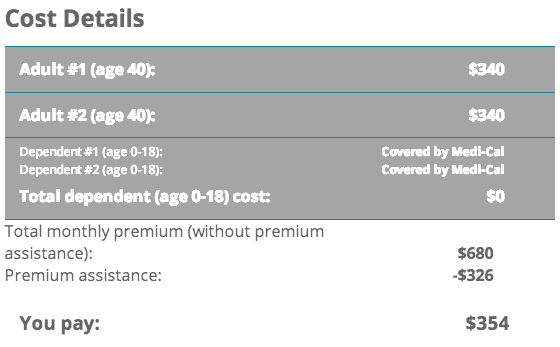
The total quoted was $354 a month after $326 a month in subsidies. I was somewhat surprised to see that the kids would be covered by Medi-Cal, which is commonly considered a welfare program for low-income families.
Here are results for a Silver plan for the family with $95,000 income:
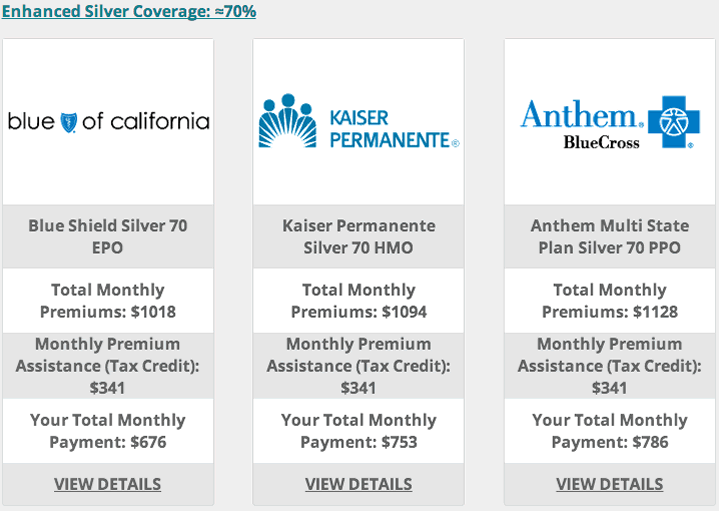
Let’s pick the cheapest Blue Cross Blue Shield option:
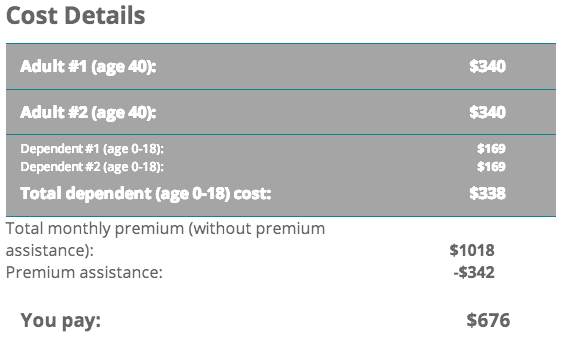
The total quoted was $676 a month after $342 of subsidy. Most of the difference between the $60,000 income figures was due to the fact that I would have to pay for dependent coverage.
Recap. The primary takeaway is that you should try and get some actual quotes, as you may be surprised by your findings. While you can play around with the California website pretty easily, note that other states may offer a much more frustrating experience at their exchange. Alternatively, you can try a comparison site like eHealthInsurance.com which also has ACA-compliant individual plans. I tried various ages up to the 60s (before Medicare kicks in at 65) and the numbers didn’t rise significantly. If I was a retired couple under 65 and on a budget, I would consider paying under $200 a month per person to be “affordable”. Even if you aren’t retired, these numbers may allow many people to pursue self-employment when otherwise they would be scared to lose employer-linked group health insurance.
The secondary takeaway is that the subsidy is significant, and it may take some planning to qualify for it upon early retirement. If you miss the income cutoff by even a small amount, you end up paying thousands more in premiums. Qualification also looks at your most recent tax return, which may not reflect your current income. If you are transitioning to early retirement, you likely had a high savings rate which means your past income might be high while your income needs in retirement could be much lower. I need to do more research on if you can get the subsidy retroactively in this type of situation.
Update: I wrote an additional post about Affordable Care Act out-of-pocket cost subsidies.
 The Best Credit Card Bonus Offers – 2025
The Best Credit Card Bonus Offers – 2025 Big List of Free Stocks from Brokerage Apps
Big List of Free Stocks from Brokerage Apps Best Interest Rates on Cash - 2025
Best Interest Rates on Cash - 2025 Free Credit Scores x 3 + Free Credit Monitoring
Free Credit Scores x 3 + Free Credit Monitoring Best No Fee 0% APR Balance Transfer Offers
Best No Fee 0% APR Balance Transfer Offers Little-Known Cellular Data Plans That Can Save Big Money
Little-Known Cellular Data Plans That Can Save Big Money How To Haggle Your Cable or Direct TV Bill
How To Haggle Your Cable or Direct TV Bill Big List of Free Consumer Data Reports (Credit, Rent, Work)
Big List of Free Consumer Data Reports (Credit, Rent, Work)
It amazes me that even here the only talk is about the lowest possible cost, subsidized insurance policy. Is everyone in America really that bad off? I retired at 58 and have not had health insurance since. I detested everything about the ACA until I actually bought a policy in 2014. An unsubsidized, $1031/month policy that covers my wife and myself. First, I would have never been able to get a policy because of pre-existing conditions. Second, even if I had been able to get a policy it would have probably been totally unaffordable and useless. The policy and the the insurance company, Florida Blue in my case, literally saved my life and did so without bankrupting me. So as to your question, can the ACA be an integral part of an early retirement strategy the answer is a resounding yes. Not only does it insure your health but it insures economic viability in the long run. And if you you are in your late 50s or early 60s and you can’t afford good health insurance for $1000/month and without blinking an eye come up with the $5000 or $6000 total out of pocket if you have to, well, you have my sympathy and you probably shouldn’t be thinking about retirement anyhow. Truly, now that I have coverage, I can’t understand why people so adamantly hate this law.
Yeah …everyone hates it until they need it. Like Social Security, people bitch about the government but I’ve never known anyone who turned that check back in at the begining of the month. Like lawyers, hate them too …until you need one to work for you.
The “subsidy” is simply an advance tax credit. My understanding is that you estimate what your expected income is for the year (likely going of the prior year tax return) and then the preliminary subsidy is based on that. When you file taxes the year after you get the subsidy (but for the year you got the subsidy), then a more accurate determination is made which reduces or increases your tax liability for the year.
It is a tax credit but the credit can be paid in advance on a monthly basis. But yes its possible that the subsidy can be adjusted when you file at the end of the year.
That is what I was thinking, that I could pay the entire “full” price and then get the tax credit upon filing taxes. I wouldn’t mind doing that, although it might be a cashflow burden for many people to come up with thousands of dollars ahead of time. I suppose it is always better to have the tax credit in-hand than hope to get it sometime in May the next year.
Wait, you mean if you get the subsidy, you don’t get the tax credit?
You’re mentioning only monthly premiums, which you will pay if you DON’T use healthcare services. The fun begins if you DO have to go to the ER or have a hospitalization.
It’s worth checking what out-of-pocket expenses for co-insurance, co-pays etc. are in case you utilize any of the healthcare services, which can run well into thousands of dollars under even “gold” level Obamacare plans. This can completely devastate one’s financial situation, negating the whole premise of an “early retirement”
I left out the deductible table for brevity, but here is the chart of deductibles, copays, and out-of-pocket maximum for the Silver 70 plan listed above:
https://www.mymoneyblog.com/wordpress/wp-content/uploads/2014/08/ppaca0b.gif
The individual medical deductible is $2,000 and the family medical deductible is $4,000 a year. The gold plan version has no deductible. I would pick the plan that fits your health level. For Gold and Silver, the max out-of-pocket is $6,250 for an individual is and $12,500 for family. If one person has a $1,000,000 illness, you’ll pay $6,000. If $6,000 “devastates” your financial situation, then I agree you are not ready for early retirement.
Jonathan,
IMHO, if your monthly premiums are $340 (after getting a tax break), plus a run-of-the-mill deductibles of $3000 a year ( relatively realistic if you in your early 60s without major health issues), with (presumably fixed) income of $60,000, it already amounts to more than 10% of your income. And that’s the best case scenario, as the tax breaks cover 50% of the premiums.
I agree the outlook is still pretty tough, my estimates have health care costs being closer to 20% of my expenses in retirement. But I still like the idea of knowing the absolute max I will have to spend each year.
I agree with Docblogger.. What about the deductibles on these programs? A friend of mine has an individual policy with aca and though she gets a small subsidy the deductible is $6000 per year and I don’t know if prescriptions are included in that $6000 deductible. The plan that she had before which disappeared after aca had a slightly higher premium, but much less of a deductible. So, aside from people who were uninsurable before aca where is the good part? One other thing.. this friend is a part time teacher… though she would love to work more hours, if she does, then the subsidy goes away.
Ugggh! We feel the pain! The very cheapest plan my husband and I could find at the Bronze level with the highest deductible was $300/mo for the both of us. In the end, we decided to go with Medi-Share (a Christian healthcare sharing program that counts as having health insurance for Obamacare) where we pay only $189/mo for both of us together. Our benefits are much better and there is even no annual or lifetime limit!
The comments here surprise me. Who can’t afford a $6,000 deductible on maybe a $150,000 procedure? Are people in this country so financially diminished and incapable that a nothing $6,000 is an insurmountable number to them? Is the best that Americans can afford is a $300/month subsidized Bronze plan? Not only has the country seemingly become a Banana Republic but its citizenry have been reduced to below Emerging Market status. The impoverishment is not just stunning it makes me wonder how a once rich and idealistic country was plundered and robbed so deftly . The “by who” part is less of a mystery.
My wife and I just went through this in N.J. As early retirees, we were paying approx. $1100 per month for the two of us to have a decent BC/BS health insurance plan…no deductibles, minimal co-pays, no referrals, we could see whoever we wanted to. Our plans are not ACA compliant, and are not being renewed. Our income is negligible (living off savings until pension and social security f.r.a. kick in), so our premiums are almost fully subsidized, BUT we will each have a $5000 deductible and an out of pocket maximum of over $13,000 per year…about what we were paying for the old premiums. This will only be an improvement if we do not need any health care in the coming year, which, given our ages, is doubtful. I had a knee replacement last year that had a $500 co-pay. Under the new plan I would have paid approx. $6000 for the deductible and co-pay; or, the equivalent of my entire year’s premiums under my pre ACA plan.
Thanks for sharing. Is your plan tagged Silver/Gold/Platinum? Just wondering if you could get a fancier metal and end up paying less overall.
Hello, Jonathan, and thank you for the courtesy of your reply. Here in beautiful South Jersey, if I am reading the website correctly, those who are getting a subsidy can only apply for bronze or silver plans. For Horizon EPO Bronze, the deductibles are $5000 per person, with a maximum family out-of-pocket expense of $12,700 per year. The more expensive Silver plan lowers the deductible to $3000 with a maximum family cost of $10,000 per year.
I am not so concerned for my family, as we could cover those costs. My issue is for the working poor, frequently featured in our local newspaper, The Philadelphia Inquirer. People who could never afford health insurance are giddy that they are getting health insurance for $20, $30, or $40 per month after subsidies, without realizing the steep deductibles. I fear that the majority of American families would be very hard-pressed to come up with $3000 or $5000 in the event of a medical emergency.
Well I think you could apply for any plan regardless of the subsidy (unless you qualify for Medicaid)
But I think it’s silly for a healthy person to pay $2000 extra in premium to reduce his deductible from let
Oops accidentally clicked submit on my cell phone… Anyway I was saying it’s silly for a generally healthy person to pay extra $2000 in premium a year to reduce his deductible from $6000 to let’s say $2000.
Since by law anything over $6000 a year is covered 100%, all plans are equal once you spend $6000 a year. And why would anyone “bet” $2000 that they will spend $4000 if they are generally healthy.
Also it doesn’t make sense for a personI about to have a major surgery to get on a gold plan if that plan has 0 deductible but maximum out of pocket since 90‰ (gold) reach $6000 at 60k and 60‰ (bronze) at 15k both of which can be the cost of minor surgeries, let alone major one.
Also if maximum out of pocket is $2000 with no deductible it only makes sense for someone who will use it all AND the difference in premium is less than $4000
Well those working poor prior to ACA were still getting sick, only they didn’t have insurance and weren’t collectively paying into the pool. So when they got sick they went to the ER, which is the single most expensive place to treat them, and now with their bronze plan they hopefully go to their doctor’s office and get treated early, which saves money.
Also, if they do have a catastrophic event and need a $100k surgery and can’t pay their $6k deductible/max out of pocket, the hospital still can claim the $94k (hopefully negotiated down) from the ACA plan, which is funded by a lot of people, most of whom didn’t need surgery, paying $20 $30 $40 per month plus the government subsidies that make up the full premiums (hundreds of dollars per person per month) funding that plan.
I don’t understand the problem here. Previously you were paying $13,200 per year for coverage plus co-pays. Now you are paying nothing for coverage (fully subsidized premiums) and the max you can pay in any one year when you need a huge amount of healthcare services is $13,000. So under no scenario are you worse off than you were, and in most years I suspect you will probably be paying around half what you were under your old plan.
Is the subsidy income-based only? My mother is retiring and will also have to live off savings for awhile before SS kicks in. She has a decent retirement fund, but won’t be able to touch that for a few more years).
So basically her income would only be interest off her savings, which is minimal. Does that mean she would still qualify for subsidies despite having a healthy savings and retirement account?
Hi, Kess. In my experience, the answer is yes, the subsidy is income based only. My wife and I are in a similar situation to your mother. We gladly took early retirement knowing we would have to live a few years off savings until my pension and my wife’s SS kicks in. We paid COBRA for as long as we could, then bought individual policies. When they expired, they were not renewed because they were not ACA compliant. The big surprise? We will be on MEDICAID because we have minimal ($5000 per year dividends and part time employment) income.
I guess the gov. has no way to check net worth ~~~really, how could they appraise real estate holdings and portfolio value as well as savings and checking account balances every day~~~ income, however, they can check based on income tax filings. We were even told that IRA distributions don’t count as retirement income as that is money we saved and are “paying ourselves”. I am wondering what would happen if I were to OVERSTATE our income for 2014 enough to get off Medicaid but still enough to get some sort of subsidy in the Marketplace. Anybody else have a similar experience or any suggestions? Thank you and best wishes, Mike
In my research I have been told by the Marketplace/healthcare.gov that if you take distributions from a ROTH IRA, they don’t count as income, but if you take distributions from a Traditional IRA or 401K which are both funded with pre-tax dollars, those distributions do count as taxable income/MAGI which is what subsidies are calculated on.
Hello..I am glad to hear that you are in the same situation as I will be when I retire early in a year or so. I too will be eligible for Medicaid as I will be living on savings and nontaxable investment income. However I don’t wish to be on Medicaid for a variety of reasons…but, if I opt out of Medicaid I am told (by a New York State of Health representative) that I also waive any right to a subsidy. So, although I can afford and am willing to pay, a premium for my health insurance, I can’t get any help with it. And why would I pay out of pocket thousands of dollars for a private plan when I can get Medicaid for “free”? Sounds like a flaw that wasn’t anticipated when the plan was crafted. Anyone have any thoughts on this?
Thanks, Serge. Although generally healthy, I know that I will need another knee replacement in the very near future. Even if I have no other health costs in the next 12 months (doubtful!), the extra $2000 in premiums mentioned above in your first paragraph would save $4000 in deductible cost. That’s a return even Jonathan would approve of!
I think the bigger point is this: for years I remained employed simply for my employer provided health insurance. When I finally made the break and retired I knew I would be paying for my coverage…first through COBRA, then on my own. I had very high hopes for “Obamacare”, but that only seems to transfer costs from premiums to deductibles. In other words, anything I might save on premiums, through subsidies for example, will be spent on deductibles. At least that’s my experience. Thanks!
Again in your case focus on Maximum out of pocket not deductible since knee replacement surgery will wipe out any deductible anyway.
But as much as I think the law is “glitchy” :for example a 30 year old earning 30k on bronze plan pays $160 after smaller subsidies in my state; a 50 year old earning 30k pays $100 for the same bronze plan after bigger subsidies. This doesn’t look fair for younger people who should pay a lot less than older people not the other way around.
Still I had an early retired friend who had a heart attack and old individual insurance plan that paid 100k (the limit) for his surgery whereas he got billed a lot more and this end up wiping much of his retirement savings. Making his future retirement unsustainable and forcing him back to work.
So you gotta appreciate Obamacare for giving you piece of mind by lifting the limit that even the most generous insurance used to have at one million per lifetime. Now the sky is the limit.
I think you are dead right. The total cost has been shifted from paying a premium and then consuming as much healthcare as you’d like because the marginal cost is zero to you (think buffet behavior) to paying a lower premium and a more significant share of each medical service you consume. I have personally seen what I interpret to be lonely old people coming in to our HMO for appointments for what appear to be primarily social visits. I think that a more pay-as-you-go mentality should eliminate that or at lease cause people to consider the most cost-effective way to pursue treatment. This should save the system billions, trillions, over time. Couple this with absolute out-of-pocket maximums and you have a system that protects those who are really in need of very expensive care and also starts to institute some much-needed cost consciousness among the end consumers of healthcare.
It’s far from perfect but some of the aspects of the ACA are well-thought-out.
Well that’s how insurance works: State Farm will pay 200k for my burned down house by taking money from you and everyone else many of whom will never ever file a claim. Even if I can’t cover my 10k deductible, State Farm will make my bank whole or the most my bank will lose is 10k.
This prevents banks from going under, why shouldn’t hospitals who must treat people in ER be made whole like banks are?
Yeah I hope people will be more discerning when going to the doctors, yet not delay going there when needed be.
Since I am quitting my job and becoming self employed I am moving on 6k deductible bronze plan, where maximum out of pocket = deductible so either I will pay 100‰ or insurance pays 100%
Now if I need some run of the mill procedure I will try clinics affiliated with pharmacy chains some of which charge under like $75 a visit or smartphone app where I pay $45 for a virtual consultation and rx. In any case if I need a several thousand dollar procedure I may even use my miles to travel to travel to South Korea and get it for $500. Kind of a hassle but c’est la vie
So glad I am an expat and I don’t have to live under the yoke of Obamacare. High quality health care that is inexpensive is available where I live. The threat of U.S. health care means I’ll probably never go back. For those who have the option I recommend looking into expatriating.